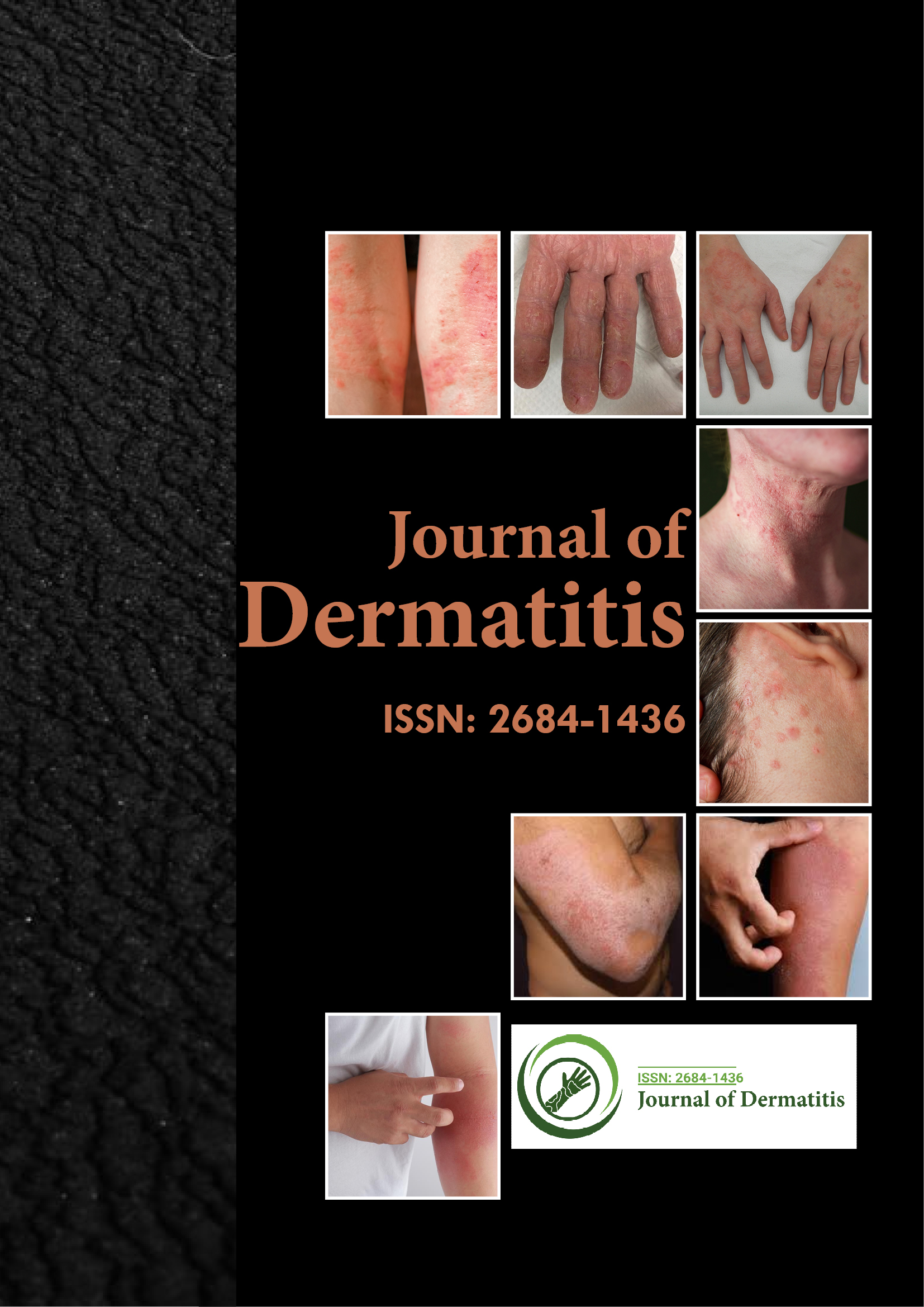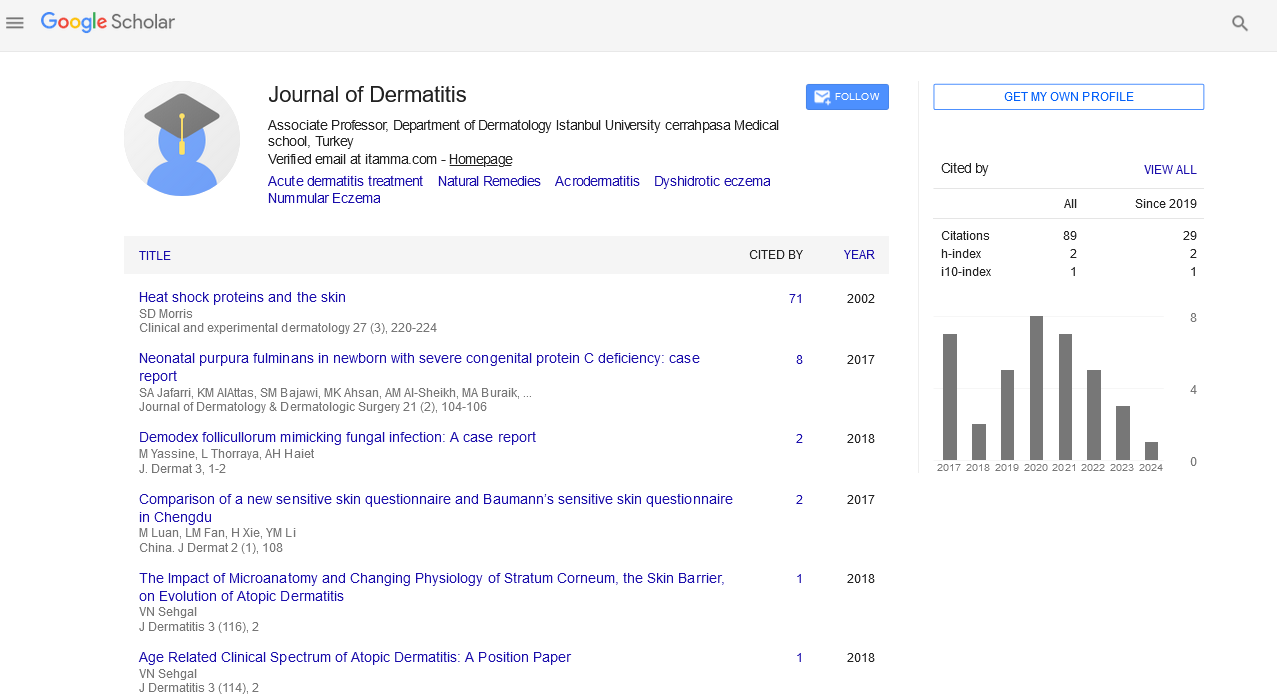Indexed In
- RefSeek
- Hamdard University
- EBSCO A-Z
- Euro Pub
- Google Scholar
Useful Links
Share This Page
Journal Flyer

Open Access Journals
- Agri and Aquaculture
- Biochemistry
- Bioinformatics & Systems Biology
- Business & Management
- Chemistry
- Clinical Sciences
- Engineering
- Food & Nutrition
- General Science
- Genetics & Molecular Biology
- Immunology & Microbiology
- Medical Sciences
- Neuroscience & Psychology
- Nursing & Health Care
- Pharmaceutical Sciences
Commentry - (2024) Volume 9, Issue 2
Immune Mechanisms in Post-Inflammatory Hyperpigmentation and its Clinical Implications
Hiroko Tanaka*Received: 29-Nov-2024, Manuscript No. JOD-24-27942; Editor assigned: 02-Dec-2024, Pre QC No. JOD-24-27942 (PQ); Reviewed: 16-Dec-2024, QC No. JOD-24-27942; Revised: 23-Dec-2024, Manuscript No. JOD-24-27942 (R); Published: 30-Dec-2024, DOI: 10.35248/2684-1436.24.9.239
Description
Post-Inflammatory Hyperpigmentation (PIH) is a common dermatological condition characterized by darker patches of skin that appear after inflammation or skin injury. This phenomenon is not only a cosmetic concern for patients but also a rich area of research for dermatologists and immunologists. Understanding the immune events that lead to PIH involves elucidating the complex exchange between the skin's immune system, melanocyte activity and various signaling pathways. This article will explain the historical context of PIH research and discuss the positive and negative aspects of understanding the immune mechanisms behind PIH.
Historically, research on IPH has evolved alongside advances in dermatology and immunology. The first evidence of skin discoloration associated with inflammation dates back to ancient medical texts, such as those of Hippocrates and Galen, which documented skin conditions and treatments. However, scientific understanding of PIH advanced significantly in the 20th century with the advent of modern dermatological research focusing on pigmentation disorders.
The immunological aspects of PIH include researchers who have studied the role of melanocytes and keratinocytes in the skin’s response to injury. The interaction between these cells is essential. Melanocytes are responsible for pigment production and their activity is influenced by various cytokines released by activated immune cells during inflammation. The extensive research on the effects of UV radiation and inflammation on the skin, clarifying the mechanisms responsible for hyperpigmentation and the role of interleukins and Tumor Necrosis Factor alpha (TNF-α) in stimulating melanocyte activity, thus linking immune responses to increased pigmentation.
In addition, immunological research has provided a better understanding of the pathogenesis of melanocytic hyperpigmentation. Activation of the immune system in response to skin injury induces a series of inflammatory mediators that lead to the upregulation of melanogenic enzymes such as tyrosinase. Subsequent studies have shown that the role of the immune system is not simply reactive. It actively regulates melanocyte activity. Research has demonstrated that multiple immune cell types, including macrophages and T cells, secrete factors that can improve or inhibit pigmentation, revealing the complexity of the skin's immune response in the context of inflammation.
Despite advances in understanding the immune processes involved in PIH, challenges remain. Negative aspects of this research include individual variability in the response to inflammation, which may lead to unexplained variations in pigmentation outcomes. Factors such as genetic predisposition, skin type and the nature of the inflammatory stimulus play an important role in the development of melanocytic hyperpigmentation, complicating effective clinical management. The need for targeted therapies that can modulate the immune response without affecting the skin's defense mechanisms is evident. Traditional treatments may include topical agents, such as hydroquinone or corticosteroids, to reduce pigmentation, but these may have side effects or may not be universally effective, further complicating the treatment process.
Furthermore, the role of social and psychological factors associated with melanocytic hyperpigmentation cannot be ignored. The expression of melanocytic hyperpigmentation often leads to psychological distress, affecting the quality of life of many people. The historical context of dermatology also reflects a tendency to emphasize treatment rather than addressing the psychosocial impacts of skin conditions. As researchers and healthcare providers gain a deeper understanding of the immunological foundations of post-inflammatory hyperpigmentation, it is essential to take a comprehensive approach that considers both clinical and psychosocial aspects.
In conclusion, the study of post-inflammatory hyperpigmentation through the lens of immunological events demonstrates the complex relationship between the skin, the immune response and pigmentation. Historical contributions from early dermatologists and contemporary researchers have created a comprehensive understanding of the condition. Although progress has been made in clarifying the pathways and mechanisms involved, further research is needed to address individual differences in response and develop effective and safe treatments. As the field of dermatology continues to evolve, it is essential that future research balances biological understanding of PIH with the associated psychosocial challenges, ensuring a comprehensive approach to patient care.
Citation: Tanaka H (2024). Immune Mechanisms in Post-Inflammatory Hyperpigmentation and its Clinical Implications. J Dermatitis. 9:239.
Copyright: © 2024 Tanaka H. This is an open access article distributed under the terms of the Creative Commons Attribution License, which permits unrestricted use, distribution, and reproduction in any medium, provided the original author and source are credited.

